Discover 11 hidden attractions, cool sights, and unusual things to do in Harpers Ferry (United States). Don't miss out on these must-see attractions: Harpers Ferry National Historical Park, John Brown's Fort, and Heyward Shepherd monument. Also, be sure to include St. Peter's Roman Catholic Church in your itinerary.
Below, you can find the list of the most amazing places you should visit in Harpers Ferry (West Virginia).
Table of Contents
Harpers Ferry National Historical Park
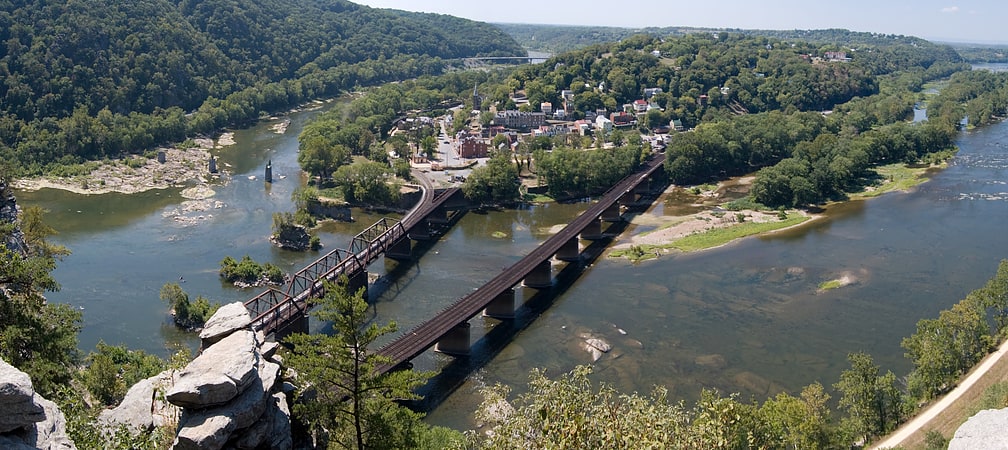
National park in the United States of America. Harpers Ferry National Historical Park, originally Harpers Ferry National Monument, is located at the confluence of the Potomac and Shenandoah rivers in and around Harpers Ferry, West Virginia. The park includes the historic center of Harpers Ferry, notable as a key 19th-century industrial area and as the scene of John Brown's failed abolitionist uprising. It contains the most visited historic site in the state of West Virginia, John Brown's Fort.
The park includes land in the Shenandoah Valley in Jefferson County, West Virginia; Washington County, Maryland and Loudoun County, Virginia. The park is managed by the National Park Service, an agency of the U.S. Department of the Interior. Originally designated Harpers Ferry National Monument in 1944, the park was declared a National Historical Park by the U.S. Congress in 1963. Consisting of almost 4,000 acres (16 km2), it includes the site of which Thomas Jefferson once wrote, "The passage of the Potomac through the Blue Ridge is perhaps one of the most stupendous scenes in Nature" after visiting the area in 1783. Due to a mixture of historical events and ample recreational opportunities, all within 50 miles (80 km) of Washington, D.C., the park was listed on the National Register of Historic Places on October 15, 1966. In 2017, the Park's Superintendent was Tyrone Brandyburg.
The park was originally planned as a memorial to John Brown, responsible for what is by far the most famous incident in Harpers Ferry's history, his 1859 raid and capture of the federal armory. NPS officials in the 1930s focused on John Brown's raid and the Civil War to justify acquiring parts of Harpers Ferry for a historical and military park. Like the figure of John Brown himself, this proved enormously controversial, with opposition from the United Daughters of the Confederacy and the Sons of Confederate Veterans.[1]
John Brown's Fort
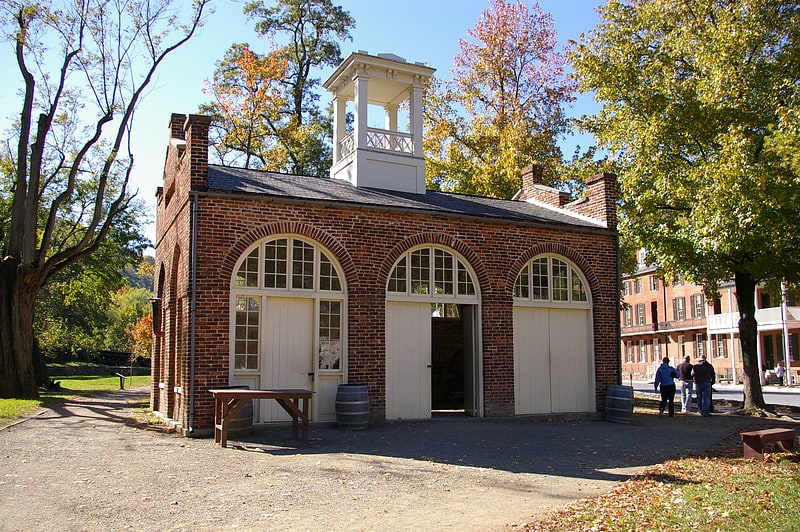
Historical landmark in Harpers Ferry, West Virginia. John Brown's Fort was originally constructed in 1848 for use as a guard and fire engine house by the federal Harpers Ferry Armory in Harpers Ferry, Virginia. An 1848 military report described the building as "An engine and guard-house 35 1/2 x 24 feet, one story brick, covered with slate, and having copper gutters and down spouts…"
The building achieved fame when it was John Brown's refuge during his 1859 raid on Harper's Ferry. It is the only surviving building of the Armory; the others were destroyed during the Civil War.
The building quickly became a tourist attraction; the words John Brown's Fort—a new name—were painted over the three doors, to attract tourists. It has been moved four times, and for most of its history was preserved on the Harpers Ferry campus of the historically black Storer College, until moved back to near its original location by the National Park Service.[2]
Heyward Shepherd monument
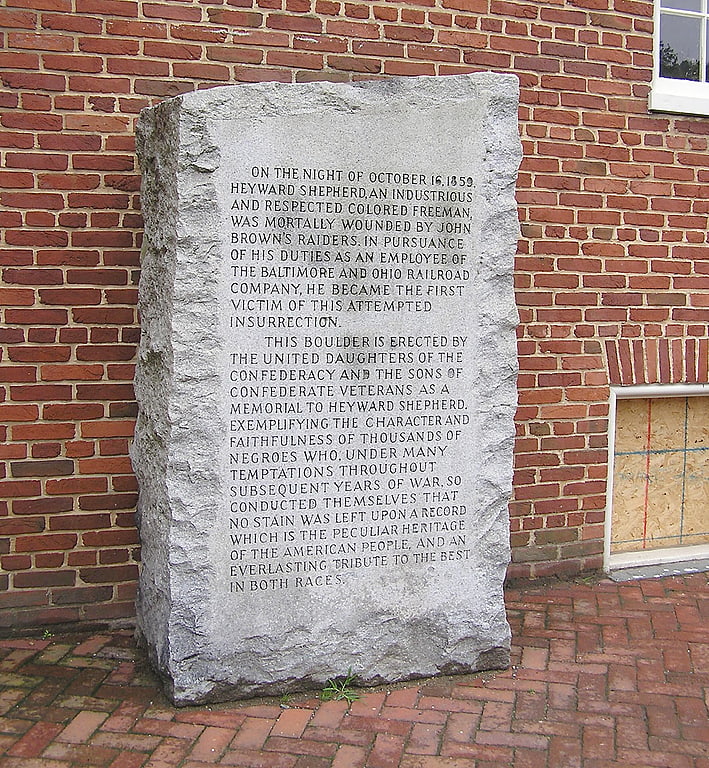
The Heyward Shepherd monument is a monument in Harpers Ferry, West Virginia, constructed in 1931. It commemorates Heyward Shepherd, a free black man, who was the first person killed during John Brown's raid on Harpers Ferry. The monument was constructed to promote the pseudo-historical Lost Cause of the Confederacy myth, by falsely claiming that Shepherd was opposed to freeing the slaves.
The monument was erected in 1931, after decades of controversy, by the United Daughters of the Confederacy (UDC) and, to a lesser extent, by the Sons of Confederate Veterans. The monument was intended to publicize the Lost Cause allegation that the enslaved were happy and did not want freedom; the UDC had a "Faithful Slave Memorial Committee". However, the grand jury Bill of Indictment lists 11 Black enslaved men who were allegedly incited to revolt by the accused. One was locked up in the Charles Town jail together with Brown, Green, and the others. The owners of two submitted claims for their losses. Some slaves were observed with weapons inside the Arsenal. The story that Washington and Allstadt's slaves were there only because they were forced to be there is what the slaves had said, after Brown's raid had failed, and their owners wanted to believe that.
A different view is provided by Osborne Perry Anderson, the only Black in Brown's party who escaped:
On the Sunday evening of the outbreak, when we visited the plantations and acquainted the slaves with our purpose to effect their liberation, the greatest enthusiasm was manifested by them—joy and hilarity beamed from every countenance. One old mother, white-haired from age, and borne down with the labors of many years in bonds, when told of the work in hand, replied: "God bless you! God bless you!" She then kissed the party at her house, and requested all to kneel, which we did, and she offered prayer to God for His blessing on the enterprise, and our success. At the slaves' quarters, there was apparently a general jubilee, and they stepped forward manfully, without impressing or coaxing. Captain Brown...was surprised and pleased by the promptitude with which they volunteered, and with their manly bearing at the scene of violence....The truth of the Harper's Ferry "raid," as it has been called, in regard to the part taken by the slaves, and the aid given by colored men generally, demonstrates clearly: First, that the conduct of the slaves is a strong guarantee of the weakness of the institution, should a favorable opportunity occur; and, secondly, that the colored people, as a body, were well represented by numbers, both in the fight, and in the number who suffered martyrdom afterward.
However, the official view, in the reports of the Virginians Lt. Col. Robert E. Lee and Governor Henry A. Wise, was that no Blacks participated voluntarily at all. Lee's report did not become public until the report of the Senate Select Committee investigating the incident, over six months later. But Wise's views were widely known, as he stated them clearly in speeches, which appeared in many newspapers.
There is no evidence that Shepherd was opposed to John Brown's plan to end American slavery, or even that he had heard of it. He thought he was dealing with robbers. Nevertheless, the monument was intended to be a reply to Blacks' glorification of Brown, in whose honor Storer College had been established in Harpers Ferry; the college placed a plaque on the Armory in 1918. There was no better place, from the UDC's point of view, for a monument to the "happy slave" than Harpers Ferry.[3]
St. Peter's Roman Catholic Church
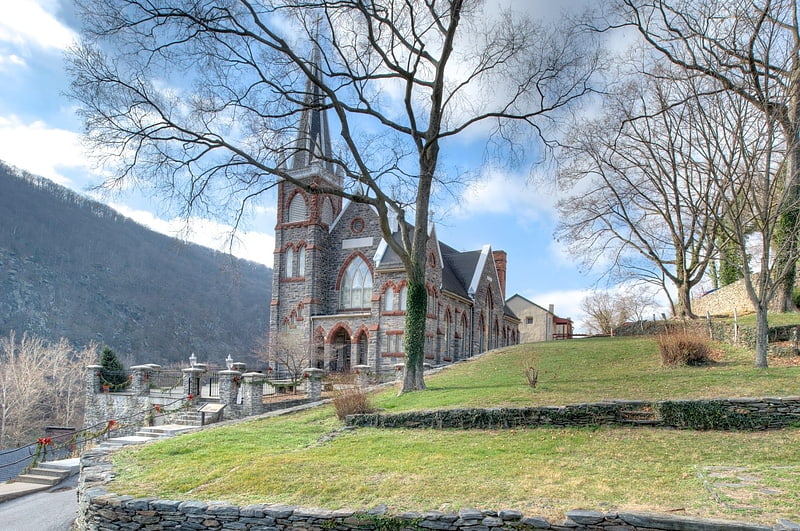
Catholic church in Harpers Ferry, West Virginia. St. Peter's Roman Catholic Church in Harpers Ferry, West Virginia occupies a prominent location on the heights above Harpers Ferry. The original church was built in 1833 in a pseudo-Gothic style which it kept through the Civil War, the only church in Harpers Ferry to escape destruction during the war. The church was extensively altered in 1896 in the then-popular Neo-Gothic style to produce the church seen today. The church commands a sweeping vista across the gorge of the Shenandoah River above its confluence with the Potomac River. The street along the side of the church building is part of the Appalachian Trail. A short trail leads from the church to Jefferson Rock. St. Peter's Church is a mission church of St. James in Charles Town. A Mass is offered at the historic church Sunday at 9:30 a.m.[4]
Address: 110 Church St, 25425 Harpers Ferry
Potomac Water Gap

Gap in West Virginia. The Potomac Water Gap is a double water gap in the Blue Ridge Mountains, located at the intersection of the states of Virginia, West Virginia and Maryland, near Harpers Ferry. At 256 feet, it is the lowest crossing of the Blue Ridge Mountains.[5]
B & O Railroad Potomac River Crossing
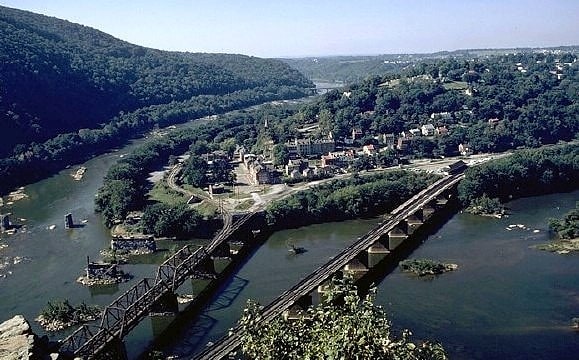
The B & O Railroad Potomac River Crossing is a 15-acre historic site where a set of railroad bridges, originally built by the Baltimore and Ohio Railroad, span the Potomac River between Sandy Hook, Maryland, and Harpers Ferry, West Virginia, in the United States. The site was added to the National Register of Historic Places on February 14, 1978 for its significance in commerce, engineering, industry, invention, and transportation.[6]
Address: C&O Canal Towpath, 21758 Harpers Ferry
Loudoun Heights
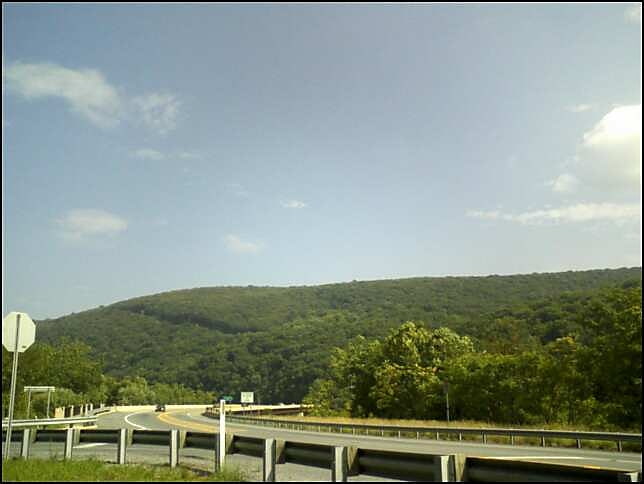
Peak in West Virginia. Loudoun Heights, sometimes referred to as Loudoun Mountain, is the first peak of the Blue Ridge Mountain south of the Potomac River in Loudoun County, Virginia and Jefferson County, West Virginia. The northwestern slope is part of Harpers Ferry National Historical Park.[7]
Jefferson Rock

Jefferson Rock is a rock formation on the Appalachian Trail in Harpers Ferry, West Virginia. It consists of several large masses of Harpers shale, piled one upon the other, that overlook the Shenandoah River just prior to its confluence with the Potomac River. It was added to the National Register of Historic Places as a contributing property of the Harpers Ferry National Historical Park on October 15, 1966.[8]
Allstadt House and Ordinary
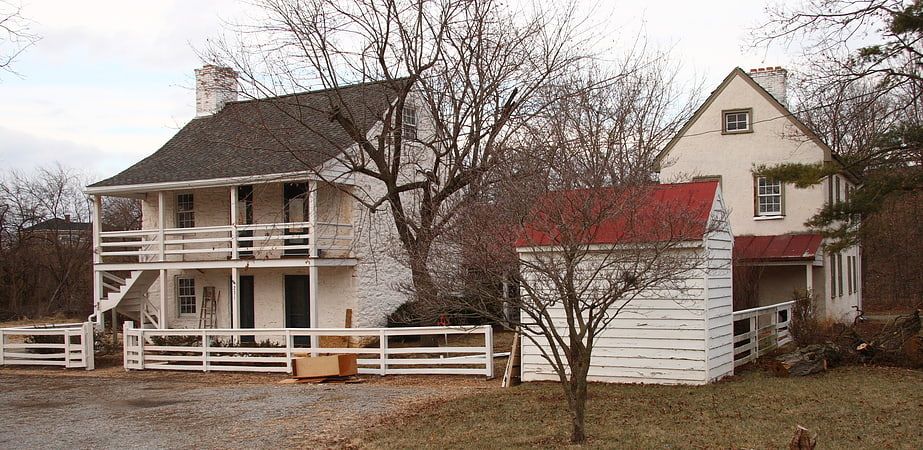
The Allstadt House and Ordinary was built about 1790 on land owned by the Lee family near Harpers Ferry, West Virginia, including Phillip Ludwell Lee, Richard Bland Lee and Henry Lee III. The house at the crossroads was sold to the Jacob Allstadt family of Berks County, Pennsylvania in 1811. Allstadt operated an ordinary in the house, and a tollgate on the Harpers Ferry-Charles Town Turnpike, while he resided farther down the road in a stone house. The house was enlarged by the Allstadts c. 1830. The house remained in the family until the death of John Thomas Allstadt in 1923, the last survivor of John Brown's Raid.
The property was placed on the National Register of Historic Places in 1985.
It was purchased by the American Battlefield Trust, which in 2019 donated it to the Harpers Ferry National Historical Park.[9]
Lee-Longsworth House
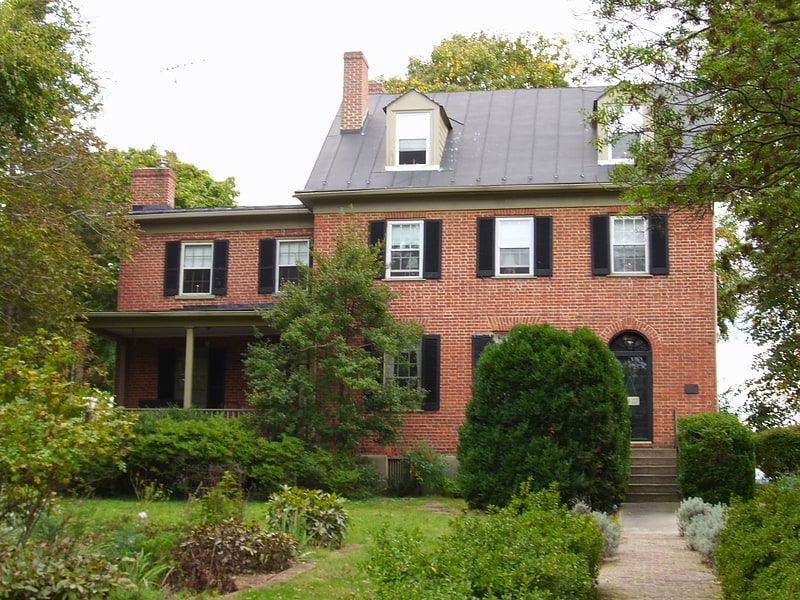
The Lee-Longsworth House in Bolivar, West Virginia, is an example of the transition from Georgian style architecture to the Federal style. It preserves significant features of interior woodwork, and is associated with the Lee family of Virginia. The property was in 1799 leased by its then owner, Thomas Wilson, to the US Government. At some point after that time, the property was purchased by Richard B. Lee, his wife Elizabeth, Edmond I. Lee and Walton Jones to Ferdinando Fairfax for $3000, subject to the government lease.
Throughout the nineteenth century the house changed hands frequently and was entangled in a number of court proceedings. During the American Civil War it is alleged that Stonewall Jackson occupied the house for a brief time,[10]
Harpers Ferry Historic District
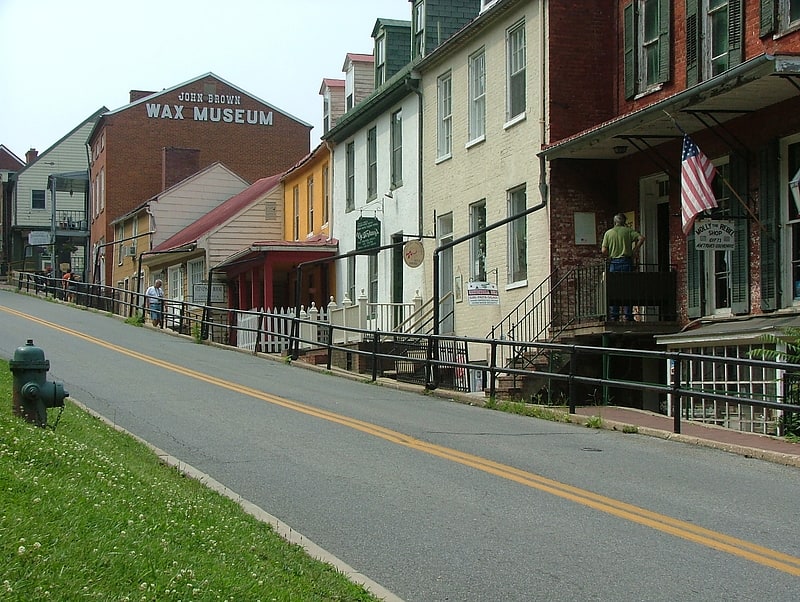
Building. The Harpers Ferry Historic District comprises about one hundred historic structures in Harpers Ferry, West Virginia. The historic district includes the portions of the central town not included in Harpers Ferry National Historical Park, including large numbers of early 19th-century houses built by the United States Government for the workers at the Harpers Ferry Armory. Significant buildings and sites include the site of the Armory, the U.S Armory Potomac Canal, the Harpers Ferry Train Station, and Shenandoah Street, Potomac Street, and High or Washington Street. The National Historic Park essentially comprises the lower, flood-prone areas of the town, while the Historic District comprises the upper town.
In the late 19th century a number of Victorian and Federalist-style houses were built on the high ground and received guests who included Mark Twain, Alexander Graham Bell and Woodrow Wilson. "Stonewall" Jackson also made the town his base of command during part of the Civil War and Thomas Jefferson said of the ferry area that: "The passage of the Patowmac through the Blue Ridge is perhaps one of the most stupendous scenes in Nature."
The historic district preserves what is essentially an intact 19th-century town that occupied a pivotal role in the American Civil War, and later as a transportation center. Thousands of tourists visit the town every year, however, parking in town is scarce. In order to better manage traffic in the small streets and enhance the feel of this historic town visitors are asked to park at the nearby Visitors Center and take the Park Service bus into the town itself. Taking the bus gives visitors a view of the traditional infrastructure that made Harpers Ferry so important prior to the 20th century.
A commuter train line stops at Harpers Ferry's historic train station and links the town with Washington D.C. with many intermediate stops.
The town was severely damaged during the Civil War, and the Armory, the only large employer, was destroyed; the only surviving building is the fire engine house, called John Brown's Fort, which is not at its original location (it traveled to Chicago and back). In addition, there was repetitive flooding in the late 19th and early 20th centuries. in the inadvertent preservation of much of the original town fabric. Two National Register properties adjoin the Harpers Ferry Historic District—the B & O Railroad Potomac River Crossing and St. Peter's Roman Catholic Church.[11]